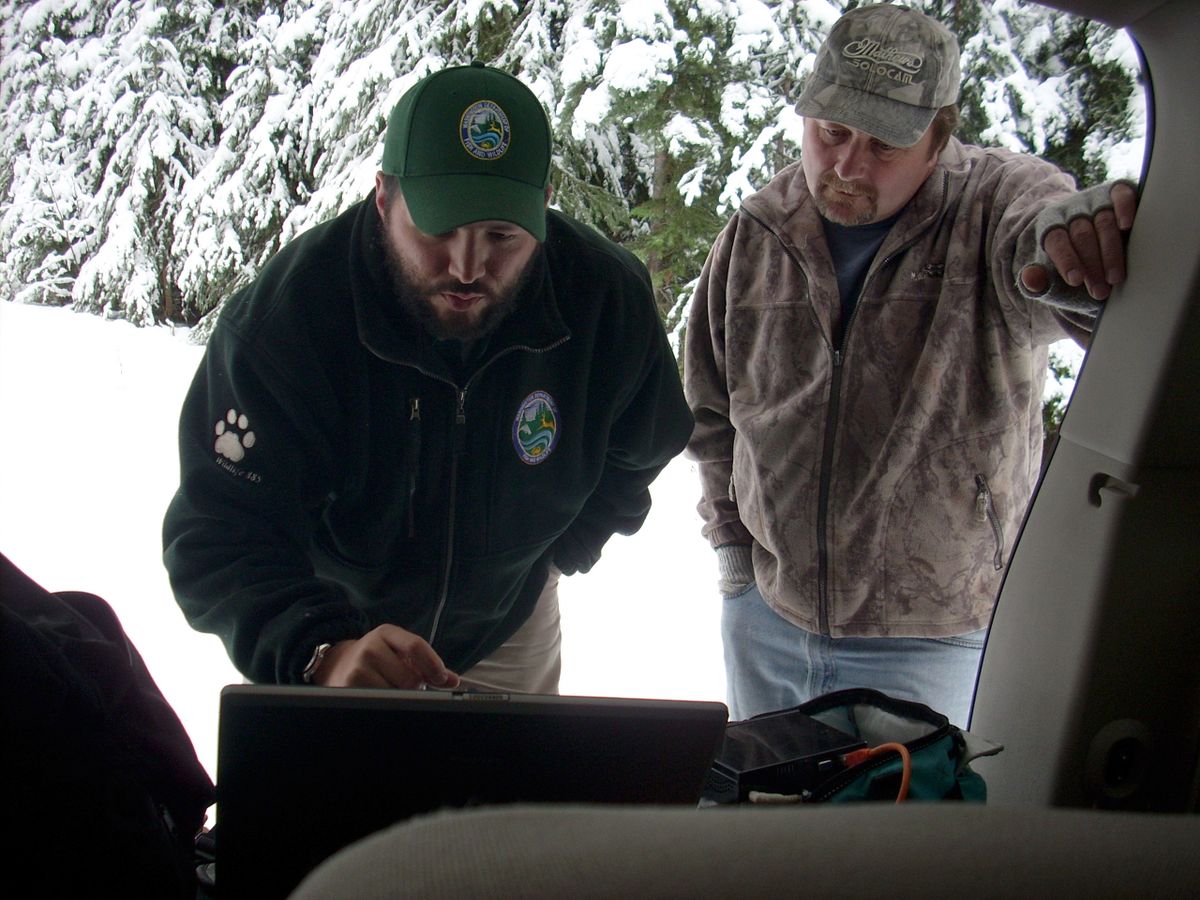‘Howl boxes’ echo wolf calls
Wildlife biologists using computers to search for packs

NORTHEAST OF USK, Wash. – As darkness fell, the howl of a wolf rose over the Selkirk Mountains – a plaintive and drawn-out sound that lingered over ridges covered with fresh snow.
After an expectant pause, the howl rang out again.
Wildlife biologist Chris Hammond listened intently, frowning a bit as the second howl crackled. The call of the wild was digital, broadcast from an 80-gigabyte computer duct-taped to a nearby tree.
“This was the one I forgot to adjust,” Hammond remarked ruefully. The volume was turned up too high.
The howl transmits three times, separated by two minutes of recording time. If wolves howl back, the sound is captured digitally. Biologists later look at spectrograms of the howling frequencies, counting how many wolves vocalized and whether they were adults or pups.
The “howl boxes” will help detect whether the aloof predators have formed a pack in Pend Oreille County.
“That’s one of the things we’d like to get to the bottom of: Do we have a reproducing pair with pups?” said Hammond, who works for the Washington Department of Fish and Wildlife.
After being hunted to near-extinction by the 1930s, gray wolves are re-colonizing former territory in Washington.
In July, biologists heard pups when they outfitted a male and lactating female with radio collars in Okanogan County’s Methow Valley. The animals could be the first confirmed wolf pack in the state.
The remote Selkirk range is also prime wolf habitat. Over the past two years, motion-triggered cameras captured multiple images of a silvery male wolf with brindle markings on its back. Scientists used bottled wolf urine to lure animals to the camera site. In August, a second wolf appeared in pictures with the male.
The sex wasn’t clear from the photo, but biologists wonder if the second wolf was female. A howl box might help unravel the mystery.
Developed at the University of Montana, howl boxes cost about $1,500 each. With a solar-power battery, they can be left in the woods for months at a time, said David Ausband, a research associate at the University of Montana Cooperative Wildlife Research Unit.
Ausband and wildlife biology student Teresa Loya designed the boxes as a cost-effective way to count wolves. The Nez Perce Tribe of Idaho helped underwrite the project.
Traditional counting methods include aerial surveys, radio collars and human howlers who sound enough like wolves to draw a response. Each is expensive, Ausband said. A collar with satellite tracking runs $3,000 to $4,000, and human howling is labor intensive, he said.
The howl boxes rely on wolves’ inquisitive and gregarious nature. Howling is “kind of an infectious thing in wolf packs,” said Scott Fisher, a wildlife biologist with the Washington Department of Natural Resources who set up the motion-triggered cameras. “It’s a social expression.”
At dawn and dusk, adult wolves often broadcast their presence. Pups are even more vocal. About 10 years ago, Ausband was playing ballads of pop singer Mariah Carey during a Canadian camping trip. The hatchback of his car was open. A nearby den of wolf pups chimed in.
Spring-born pups are left alone while the pack’s adult members are on summer hunts, Ausband said. So last summer, researchers tested the howl boxes in central Idaho.
“The pups are howling constantly,” he said. “They’re sitting in the rendezvous sites, waiting for adult wolves to come back with food.”
In recordings of captive wolves, researchers can identify individual animals by “voice printing” the frequencies of their howls. Ausband isn’t sure howl boxes will ever have that capability.
“When you’re recording in the wild, other sounds are intruding,” he said. “You’ve got the wind, the creek – even the Jake brakes from logging trucks.”
Hammond borrowed two boxes for his research in Pend Oreille County. At a trailhead near Sullivan Lake, he scrambled up a snowy embankment to retrieve one. Anticipation grew as Hammond plugged the box into a laptop. Earlier in the week, hunters said they spotted four wolves nearby.
“Nothing on the first evening,” Hammond reported as he looked at the results. “… Nothing on the next morning. … Nothing on the next evening. … Nothing, nothing.”
As they drove to the next box location, Hammond and Fisher scanned the snow for tracks. They saw moose, deer, squirrel and coyote tracks, but no wolf sign.
Near Baldy Mountain, Hammond retrieved a second howl box. In the winter of 2006, loggers reported seeing wolves nearby, drawn by the deer and elk that came to browse on the tops of felled trees. The picture of the two wolves together was also taken in the vicinity. But the box didn’t record any howls this week.
The absence of recorded howls doesn’t mean wolves aren’t present, Hammond said. A lone wolf might not broadcast its location.
“If you’re a dispersing wolf and you respond to other wolves’ howling, you could be accepted into the pack or you could get torn to shreds,” Fisher said. “It can be a pretty risky venture.”
Hammond and Fisher scouted a new location for the box, securing it to a tall Douglas fir on a ridgeline. The site had good acoustics, Hammond said, noting the bowl-shaped valley. The sound produced by howl boxes carries one to two miles, as detected by human ears.
“The wolves can hear it farther than we can. Their ears are keener,” Hammond said.
“How cool would it be to hear wolves howling in Washington?” said Fisher, who frequently heard wolf choruses when he worked in Alaska.
A mournful, digital howl soon floated over the valley. It was repeated once, then twice.
But no answer came. The notes hung in the air, then faded to silence.